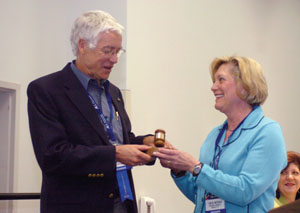
New AACR president Peter A. Jones, M.D., recieves the gavel from former president Lynn M. Matrisian, Ph.D., during the business meeting at the 96th American Association for Cancer Research (AACR) annual meeting Monday at the Anaheim Convention Center.
photo by AACR/Phil McCarten
VUMC plays central role in national cancer meet
ANAHEIM, Calif. — With help from eight gigantic projection screens dangling from the ceiling of a cavernous convention hall, Vanderbilt University Medical Center's Lynn Matrisian, Ph.D., Ingram Professor of Cancer Research and professor and chair of Cancer Biology, was highly visible here at this week's 96th annual meeting of the American Association for Cancer Research (AACR).
Ending her year-long reign as president of the world's largest and oldest cancer research society, Matrisian passed the gavel and the responsibilities of the office to her successor, Peter Jones, M.D., at the business meeting on Monday, April 18. Matrisian will continue to serve the society as past-president in the coming year.
As president, Matrisian was seen on the 'big screen' several times during the conference — she provided a primer on cancer biology at the public forum, gave the welcome address at the plenary lecture, detailed her lab's research in the presidential lecture and co-chaired a special session on late-breaking research developments.
In her plenary address, Matrisian outlined the importance of these meetings in facilitating communication and forging collaborations among basic, translational and clinical researchers.
“This meeting is all about communication,” Matrisian said. “These transdisciplinary teams will streamline the translation of basic research into new cancer therapies.” She encouraged attendees to “broaden your horizons by attending sessions outside your field, because those discussions may provide the basis for your future research.”
Such scientific tête-à-têtes, however, are not the sole goal of the AACR meeting. The society also organizes a public forum to communicate recent advances in cancer research to cancer survivors, advocates and the general public. In this year's forum, entitled “Progress and New Hope in the Fight Against Cancer,” Matrisian broke down the overwhelmingly complex process of cancer and its arcane vernacular into clear and understandable terms. Her presentation, a primer on the basic biology of what goes wrong in cancer cells, served as a foundation for the following presentations illustrating the importance of basic research in particular types of cancer.
“If the general public doesn't understand cancer research, we all lose,” Matrisian said.
Amid the startling cancer statistics presented at the public forum, Andrew von Eshenbach, M.D., director of the National Cancer Institute, offered a message of hope for the next decade. “We are poised to eliminate the suffering and death due to cancer by 2015,” Eshenbach proclaimed. This optimistic declaration will serve as a challenge to the cancer research community to focus on stopping cancer before it gets a foothold.
That goal — to stop cancer early — is a focus of Matrisian's own research. In her presidential address, she discussed how matrix metalloproteinases (MMPs), enzymes thought to be important in tumor invasion and metastasis, might play an important role in earlier stages of cancer. She detailed the history of these enzymes, including her work on MMP inhibition in a number of different cancer models.
Other conference highlights:
• Vanderbilt University Medical Center and Vanderbilt-Ingram Cancer Center were well-represented at the conference, with dozens of abstracts presented by VUMC/VICC researchers, and several VUMC/VICC faculty leading symposia in their respective fields of expertise.
• Raymond DuBois, M.D., Ph.D., director of the Vanderbilt-Ingram Cancer Center, moderated a press briefing on recent discoveries about the use of COX-2 inhibitors, such as Celebrex, in cancer prevention. The panelists presented data demonstrating that the COX-2 inhibitor Celebrex inhibits the early inflammatory response seen in patients at risk for colon cancer and can effectively suppress colon tumor formation in mice when given at low doses in combination with the cholesterol-lowering drug, Lipitor. Also, long-term use of nonsteroidal anti-inflammatory drugs (NSAIDs), such as aspirin and ibuprofen, reduced the incidence of oral cancer by 65 percent in light to moderate smokers.













